Kenya’s cultural heritage is becoming universally accessible
From the heroes of Kenya, to the carvings and sculptures of the Shona of Zimbabwe, the Makonde of Tanzania and the Karamojong of Uganda to the calabash artwork of West Africa, internet users can now explore the diversity and richness of Africa’s culture and heritage on their desktop and mobile devices.
We’ve partnered with the Kenya National Archives & Documentation Centre to extend its efforts to preserve Africa’s cultural heritage. The result is the outcome of one of Google Cultural Institute’s biggest digitization projects on the continent. Today we’re launching 8 curated exhibits and more than 1,000 items on our platform.
Mashujaa Wetu
Kenya has her own heroes; men and women who cannot be forgotten because they made her who she is today.

Image and the exhibit here.
One highlight is the launch of the Mobile App of the National Archives of Kenya which provides access to a rich trove of rare artifacts, documents, and important stories to users. This is the first partner app in Kenya built with Google Cultural Institute technologies, and the third in Africa. With the launch of this App we intend to help more people understand what makes Africa such an amazing continent.

Mobile App available for download here.
African Carvings
They are carvings of wood, stone and metal most of which are showcased here.
Whether it’s highlighting the history of Lagos, helping the world retrace the steps of Nelson Mandela or preserving the diversity of dazzling african ceremonies, Google’s Cultural Institute is helping to preserve and tell the story of Africa on a global scale. We are excited that users will be able to easily access these, and more, artefacts, stories and history of Kenya and the continent.
====
Le patrimoine culturel du Kenya désormais universellement accessible
Des héros kenyans, aux sculptures d’art Shona au Zimbabwe, Makondé en Tanzanie et Karamojong en Ouganda en passant par l’art de la calebasse en Afrique de l’Ouest, les internautes peuvent désormais découvrir la diversité et la richesse du patrimoine culturel de l’Afrique depuis leur ordinateur et leurs appareils mobiles.
Nous nous sommes associés au Kenya National Archives & Documentation Centre (Centre national des archives et de la documentation du Kenya) afin de poursuivre les efforts de préservation du patrimoine culturel africain. Le projet de numérisation réalisé sous l’égide du Google Cultural Institute constitue l’une des initiatives les plus importantes lancées sur ce continent. Nous inaugurons aujourd’hui 8 expositions auxquelles s’ajoutent la présentation de plus de 1 000 objets sur notre plateforme.
Mashujaa Wetu
Le Kenya a ses héros, ces hommes et ces femmes qui sont restés dans la mémoire collective, car ils ont façonné le pays que l’on connaît aujourd’hui. Image et Exhib ici.
Élément majeur de ce projet, le lancement de l’Application mobile des National Archives of Kenya (Archives nationales du Kenya) qui permet aux utilisateurs d’avoir accès à un véritable trésor comprenant des artefacts et des documents rares ainsi que des récits de grande valeur. Il s’agit là de la première application partenaire, la troisième en Afrique, réalisée au Kenya grâce aux technologies du Google Cultural Institute. Grâce au lancement de cette application, notre but est d’aider un plus grand nombre de gens à comprendre ce qui fait de l’Afrique un continent d’exception.
Sculptures africaines
Il s’agit de sculptures en bois, en pierre et en métal dont la plupart sont exposées ici :
Que ce soit pour illustrer l’histoire du Lagos, vous aider à marcher sur les pas de Nelson Mandela ou préserver la diversité éblouissante des cérémonies africaines, le Google’s Cultural Institute a pour mission de préserver et de raconter l’histoire de l’Afrique au monde entier. Nous nous réjouissons à la perspective que les internautes puissent accéder facilement à ces artefacts, à ces récits et à bien plus encore ainsi qu’à l’histoire du Kenya et de ce continent.
Please view the original post at http://africa.googleblog.com/2015/10/kenyas-cultural-heritage-is-becoming.html


